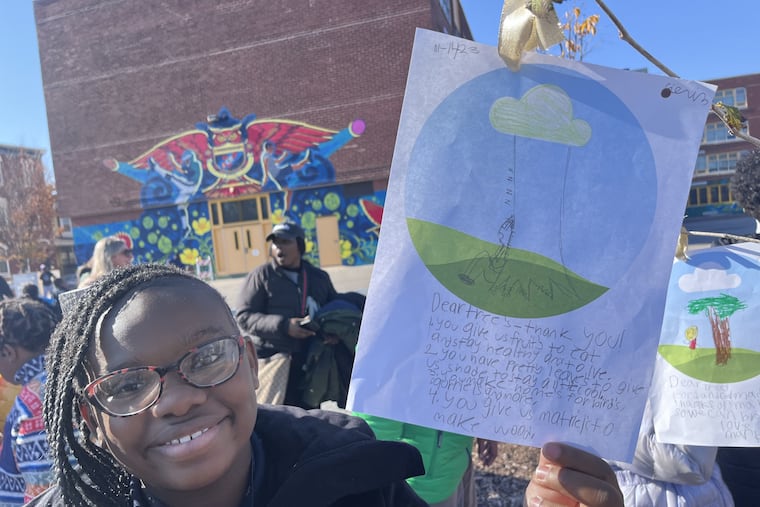Philly’s ambitious tree plan gets a $12M boost from federal grant
A federal grant is helping the city kick off a 10-year plan to increase the tree canopy to 30%.

Ciani Wilson, a student at the James Rhoads School in West Philly’s Mill Creek neighborhood, hung a note Thursday on a young filbert tree on school grounds to thank all trees for providing food, homes for squirrels and birds — as well as lumber.
She wrote, “you have pretty leaves to give us shade to stay a little cool.”
Cooling is one of the goals of the city’s first Philly Tree Plan, which was launched earlier this year in an effort to plant thousands of trees over the next decade to increase overall canopy to 30% in all neighborhoods. A new $12 million grant as part of President Biden’s Inflation Reduction Act will be used to jump start the plan, officials said at a news conference at the school on Thursday.
Wilson was one of a group of children who appended thank you notes to newly planted trees next to the school’s playground before the event, which detailed how the grant money would be spent, as well as formation of a new coalition of public and private groups formed to carry out the plan.
“Every Philadelphian deserves to live in a community with the shade, clean air, and beauty a healthy tree canopy provides,” said Mayor Jim Kenney, who became emotional when he spoke of the “love notes” to the trees left by the children.
How the money will be used
“We’re very excited because we just released the Philly Tree Plan in February of this year,” said Erica Smith Fichman, acting manager of Parks and Recreation’s urban forestry unit. “And then we get this grant that essentially would cover all aspects of the plan.”
Parks and Recreation applied for a $50 million grant from the U.S Department of Agriculture’s Forest Service. In September, the Forest Service awarded more than $1 billion in grants nationwide to plant and maintain trees, combat extreme heat and climate change, and improve access to nature with money from the Inflation Reduction Act. But officials knew getting the full amount they requested was a longshot.
Smith Fichman said the city is happy to get the $12 million, which can get put to use immediately given that the Philly Tree Plan was ready to implement. The five-year grant will be used by the newly formed group of organizations called the Philly Tree Coalition, which will be housed at The Pennsylvania Horticultural Society, which will also oversee additional fundraising. The Philly Tree Plan has been estimated to cost $25 million a year to implement, so additional fundraising will be important, Smith Fichman said.
The coalition includes both the city’s Parks and Recreation department and Office of Transportation and Infrastructure, and Office of Sustainability, as well as the school district. It also includes nonprofits: Pennsylvania Horticultural Society, Fairmount Park Conservancy, PowerCorpsPHL, and Sustainable Business Network of Greater Philadelphia. The Public Health Management Corporation will oversee the administration of the grant.
» READ MORE: Philly to hire its first city forester, and plant thousands of trees over the next decade
Trees in priority areas
Smith Fichman said the grant money, which comes in addition to city and privately raised funds for the Philly Tree Plan, must be used in environmental justice areas, which refers to communities where significant numbers of people live at or below the federal poverty line, and identify as non-white. Those areas also tend to be heat islands, which are hotter than other parts of a community because of the lack of shade and amount of asphalt, concrete and buildings.
The money will be used to beef up existing programs or start new ones, including hiring staff. More than $1 million will be given to small community groups across the city to start tree projects.
The school district plans to plant, and maintain, trees in priority areas. And the city will use its share of the grant to start planting trees and maintaining existing trees. Agencies will design tree scapes in areas with sidewalks capable of handling additional trees. Smith Fichman said the agencies will determine if sidewalks need to be repaired before they can handle healthy trees. They will also work with residents to support them in making the space manageable.
Trees beautify, filter pollution, store carbon, provide habitat for wildlife, and boost health of residents as green space through their canopies. But they also grow roots that can upend sidewalks, drop limbs, and dump leaves and bark onto narrow streets and curbs that residents often don’t, or can’t maintain. Maintenance of sidewalk trees has been a recurring complaint by residents.
Nonprofits within the coalition will support a range of services.
For example, Matt Rader, president of the Pennsylvania Horticultural Society, said the group will use the funds it receives to expand its existing Tree Tenders program. The program will help residents organize and plant 1,700 trees that were delivered this week. It is devising a separate program to help residents maintain the trees, with a paid component to help with watering, mulching and pruning.
PowerCorpsPHL is creating a new urban forestry crew with the funds. PowerCorpsPHL hires unemployed and underemployed 18- to 30-year-olds in a paid 4- to 24-month program. Julia Hillengas, executive director of the nonprofit said 50 young people will be trained over five years in tree care. They can earn from $15 to $20 an hour and are often hired by private contractors.
Meanwhile, the Sustainable Business Network of Greater Philadelphia is developing a program for small businesses to enter the field of urban forestry.
Maura McCarthy, CEO of the Fairmount Park Conservancy, said new trees are sorely needed.
“Most of our forests are at the end of their life span,” McCarthy said. “So within the parks, we get to focus on keeping the canopy growing the canopy making it healthier.”